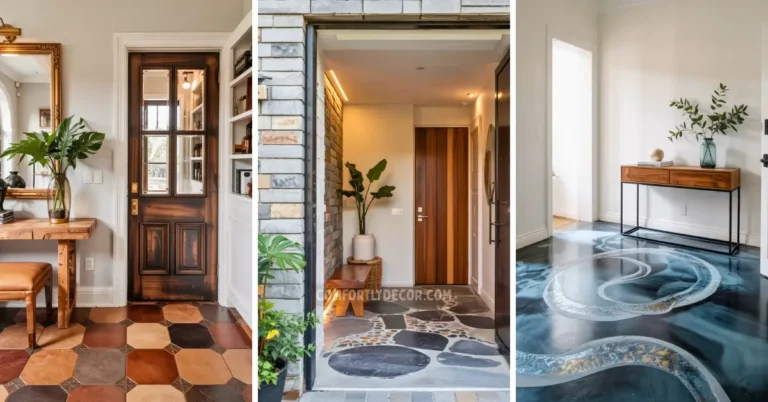How to Remove Paint From Wood Floors: A DIY Guide
So, you have had a little… artistic accident. A rogue paintbrush, a tipped-over can, or maybe the previous homeowner had a questionable taste in floor decor. Whatever the reason, you are now the proud owner of a wood floor with an unwanted paint job. You should not panic. You have come to the right place. I have been there, staring at a splotch of dried latex, wondering if my beautiful hardwood was ruined forever. Spoiler alert: it was not.
Getting paint off wood floors can feel like a Herculean task, but with a little know-how and the right approach, you can restore your floors to their former glory. This guide will walk you through everything you need to know about how to remove paint from wood floors, from identifying the mess to the final cleanup. We will cover different methods, what tools you will need, and how to avoid making things worse. Ready to get your floor back? Let’s get scraping.
First Things First: What Kind of Mess Are We Dealing With?
Before you start throwing random chemicals at the problem (please don’t do that), you need to figure out what type of paint you’re up against. This is the most crucial step because the wrong method can damage your floor’s finish or just… not work at all. It is like trying to open a can with a spoon; you might get there eventually, but it is going to be messy and frustrating.
Here’s a quick rundown of the usual suspects:
1. Latex or Water-Based Paint:
The most common type of paint for interior walls. If you are lucky, this is what you are dealing with. It is relatively easy to clean up, especially if it’s fresh. It dries fast and cleans up with water.
2. Oil-Based Paint:
Oil based paint is the heavyweight champion of durability. It dries slow, hardens into something resembling a rock, and laughs in the face of soap and water. You will need something stronger to tackle this.
3. Acrylic Paint:
Acrylic paint often used for arts and crafts, this paint is water-based but becomes water-resistant when it dries. It’s a bit of a middle-ground challenge.
How to Tell Them Apart
So, how do you play detective with a paint spill? It’s simpler than it sounds.
- Find a small, inconspicuous spot on the paint spill.
- Dab a cotton ball with some rubbing alcohol and hold it on the spot for about 30 seconds.
- Rub the area. If the paint starts to soften and come off, you’re likely dealing with latex or water-based paint.
- If the alcohol does absolutely nothing, you’re probably facing oil-based paint. Time to bring out the big guns.
Knowing your enemy is half the battle won. Now, let’s gear up.
Gearing Up: Your Paint-Removal Arsenal
You wouldn’t go into battle without armor, right? Same principle applies here. Before you start, gather all your supplies. Trust me, you don’t want to be mid-scrape when you realize your gloves are still in the garage.
Essential Safety Gear
I know, I know, safety warnings are boring. But paint strippers and even heat guns can be nasty. So, humor me.
- Gloves: Chemical-resistant gloves are a must, especially if you’re using a paint stripper.
- Safety Glasses: Protect your peepers from splashes and flying paint chips.
- Mask or Respirator: Good ventilation is key, but a mask will stop you from inhaling fumes or dust.
The Tools of the Trade
Your choice of tools will depend on the method you choose (we’ll get to that next).
- For Scraping: A plastic putty knife, an old credit card, or a dedicated plastic scraper. Avoid metal scrapers on your finished floor unless you’re planning to refinish it anyway—they will scratch it.
- For Heat Application: A good old-fashioned hairdryer or a more powerful heat gun.
- For Chemical Stripping: A quality paint stripper (more on this below), paintbrushes to apply it, and rags.
- For Sanding: Sandpaper of various grits (medium to fine).
- For Cleanup: A bucket, warm water, mild dish soap, and plenty of clean rags or paper towels.
Let’s Get This Paint Off: Choosing Your Method
Okay, you’ve identified the paint and you’ve got your gear. It’s time to decide on your plan of attack. How you get paint off wood floors depends on whether the paint is wet or dry, and what type it is.
Method 1: The Gentle Approach (For Wet Latex/Water-Based Paint)
If you just spilled the paint, stop reading and go clean it up! Seriously, time is of the essence.
- Blot, Don’t Wipe: Use a damp paper towel or cloth to blot up as much of the wet paint as you can. Wiping will only spread the mess.
- Soap and Water: Mix a few drops of mild dish soap with warm water.
- Scrub-a-Dub: Dip a clean cloth in the soapy water and gently scrub the remaining paint. Work from the outside of the spill inward to prevent spreading it further.
- Rinse and Dry: Use a clean, damp cloth to rinse the area, then dry it thoroughly with another cloth. You don’t want water sitting on your beautiful wood floors.
Method 2: The “Oops, It Dried” Approach (For Dry Latex/Water-Based Paint)
So you didn’t notice the drip until it was dry? No worries. This is still manageable.
- Start with a Scrape: Grab your plastic putty knife or scraper. Hold it at a low angle and gently try to pry the paint off the floor. Often, dried latex paint will peel right off the smooth surface of a finished wood floor.
- Add a Little Heat: If scraping alone doesn’t work, grab a hairdryer. Set it to a warm (not scorching) setting and hold it a few inches from the paint for 20-30 seconds. This will soften the paint, making it easier to scrape off.
- Last Resort Lubricants: If stubborn bits remain, you can try a little rubbing alcohol or even a bit of olive oil on a cloth to loosen the paint’s grip before scraping again. Just be sure to clean the area with a damp cloth afterward.
Method 3: The Heavy Hitter (For Dry Oil-Based Paint)
Alright, this is where things get serious. Oil-based paint is designed to stick, and it does its job well. This is how to remove paint from hardwood floors when it really doesn’t want to leave. You have two main options here: a heat gun or a chemical stripper.
Using a Heat Gun
A heat gun is like a hairdryer on steroids. It gets extremely hot, so be careful.
- Safety First: Make sure the area is well-ventilated. Open windows and turn on a fan. Keep the heat gun away from flammable materials.
- Heat and Scrape: Hold the heat gun 2-3 inches away from the paint. Move it back and forth continuously to avoid scorching the wood. The paint will start to bubble and wrinkle—that’s your cue.
- Scrape It Off: While the paint is soft, use your scraper to lift it off. It should come off in rubbery sheets.
- Clean Up: Once the paint is gone, there might be a sticky residue. Clean the area with a cloth dampened with mineral spirits, then wipe with a clean, damp cloth and dry thoroughly.
Using a Chemical Paint Stripper
This is often the most effective way to remove paint from wood floors, but it’s also the most intense. IMO, save this for when you have a large area to clear or when heat fails.
- Choose Your Weapon: Look for a stripper that’s safe for wood floors. There are citrus-based and soy-based gels that are less toxic than traditional chemical strippers. Read the label!
- Prep the Area: Open all the windows. Cover adjacent areas you don’t want the stripper to touch. Put on your safety gear.
- Apply the Stripper: Use a paintbrush to apply a thick layer of the stripper over the paint. Don’t be shy with it.
- Wait for It: Let the stripper sit for the time recommended by the manufacturer (usually 15-30 minutes, but can be longer). You’ll see the paint bubble and lift.
- Scrape and Remove: Use your plastic scraper to remove the gunk. It will be a gooey mess of stripper and paint. Wipe it onto newspaper or into a disposable container.
- Neutralize and Clean: After scraping, you need to neutralize the stripper. The product instructions will tell you what to use—often mineral spirits or water. Clean the area thoroughly afterward.
What About Sanding?
Sanding is an option, but it should be your absolute last resort, especially for small spots. Why? Because sanding will remove the paint, but it will also remove the finish on your wood floor.
If you sand a spot, you’ll be left with a dull, unprotected patch of wood that looks completely different from the rest of your floor. You would then need to stain and refinish that spot to match, which is a whole other project. Sanding is really only a good idea if you’re planning to refinish the entire floor anyway.
The Aftermath: Cleaning and Finishing
You did it! The paint is gone. But you’re not quite finished yet.
- Thorough Cleaning: No matter which method you used, give the area a final, thorough cleaning. A simple solution of warm water and a few drops of dish soap will do. This removes any leftover residue from chemicals, heat, or the paint itself.
- Rinse and Dry: Wipe with a clean, water-dampened cloth, then immediately dry the floor completely.
- Assess the Damage: Take a close look at the wood. Is the finish intact? Or did your paint removal efforts leave it looking a bit dull or scratched?
- Touch-Up Time: If the finish looks a little worn, you can often restore its shine with a wood floor polish or wax that matches your floor’s existing finish. For minor scratches, a touch-up marker or a bit of stain might do the trick.
FAQs
Your Floor is Worth the Effort
Removing paint from wood floors can be a pain, but it’s totally doable. The key is to be patient, use the right method for your specific situation, and always, always test in an inconspicuous area first. Your floors add so much warmth and character to your home, and putting in a little elbow grease to keep them looking great is a worthy investment. So, take a deep breath, grab your scraper, and go reclaim your beautiful wood floors. You’ve got this.

I am Mindy Medford, a home décor, paint, and design specialist with over a decade of hands-on experience transforming ordinary spaces into cozy, personality-packed havens. Since 2013, I have been helping homeowners discover the art of beautiful yet practical design. I share my love for color, texture, and layout—making stylish interiors & exteriors feel achievable for everyone. Whether it’s picking the perfect paint shade or reimagining a small space, I’m here to guide and inspire.







